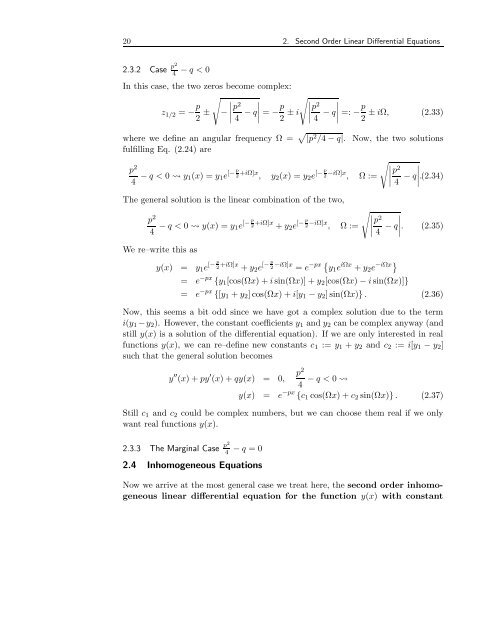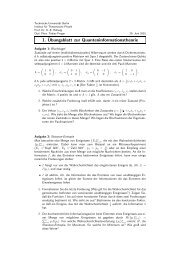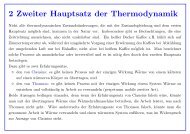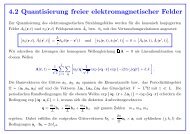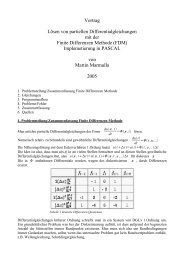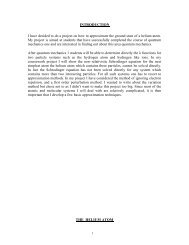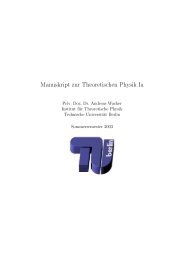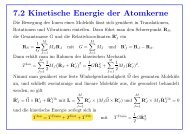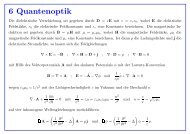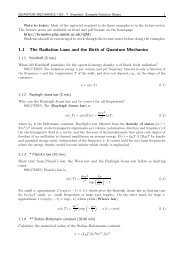2. SECOND ORDER LINEAR DIFFERENTIAL EQUATIONS
2. SECOND ORDER LINEAR DIFFERENTIAL EQUATIONS
2. SECOND ORDER LINEAR DIFFERENTIAL EQUATIONS
You also want an ePaper? Increase the reach of your titles
YUMPU automatically turns print PDFs into web optimized ePapers that Google loves.
20 <strong>2.</strong> Second Order Linear Differential Equations<br />
<strong>2.</strong>3.2 Case p2<br />
4<br />
− q < 0<br />
In this case, the two zeros become complex:<br />
z1/2 = − p<br />
2 ±<br />
<br />
<br />
− <br />
p<br />
<br />
2<br />
<br />
− q<br />
p<br />
4 = −p ± i<br />
2 2<br />
4<br />
<br />
<br />
− q<br />
<br />
=: −p ± iΩ, (<strong>2.</strong>33)<br />
2<br />
where we define an angular frequency Ω = |p2 /4 − q|.<br />
fulfilling Eq. (<strong>2.</strong>24) are<br />
Now, the two solutions<br />
p2 4 − q < 0 y1(x)<br />
p<br />
[−<br />
= y1e 2 +iΩ]x ,<br />
p<br />
[−<br />
y2(x) = y2e 2 −iΩ]x ,<br />
p<br />
Ω :=<br />
2<br />
<br />
<br />
− q<br />
4 .(<strong>2.</strong>34)<br />
The general solution is the linear combination of the two,<br />
p 2<br />
4<br />
p<br />
[−<br />
− q < 0 y(x) = y1e 2 +iΩ]x p<br />
[−<br />
+ y2e 2 −iΩ]x , Ω :=<br />
We re–write this as<br />
<br />
p 2<br />
p<br />
[−<br />
y(x) = y1e 2 +iΩ]x p<br />
[−<br />
+ y2e 2 −iΩ]x = e −px y1e iΩx + y2e −iΩx<br />
= e −px {y1[cos(Ωx) + i sin(Ωx)] + y2[cos(Ωx) − i sin(Ωx)]}<br />
4<br />
<br />
<br />
− q<br />
. (<strong>2.</strong>35)<br />
= e −px {[y1 + y2] cos(Ωx) + i[y1 − y2] sin(Ωx)} . (<strong>2.</strong>36)<br />
Now, this seems a bit odd since we have got a complex solution due to the term<br />
i(y1 −y2). However, the constant coefficients y1 and y2 can be complex anyway (and<br />
still y(x) is a solution of the differential equation). If we are only interested in real<br />
functions y(x), we can re–define new constants c1 := y1 + y2 and c2 := i[y1 − y2]<br />
such that the general solution becomes<br />
y ′′ (x) + py ′ (x) + qy(x) = 0,<br />
p2 y(x) =<br />
− q < 0 <br />
4<br />
e −px {c1 cos(Ωx) + c2 sin(Ωx)} . (<strong>2.</strong>37)<br />
Still c1 and c2 could be complex numbers, but we can choose them real if we only<br />
want real functions y(x).<br />
<strong>2.</strong>3.3 The Marginal Case p2<br />
4<br />
− q = 0<br />
<strong>2.</strong>4 Inhomogeneous Equations<br />
Now we arrive at the most general case we treat here, the second order inhomogeneous<br />
linear differential equation for the function y(x) with constant


